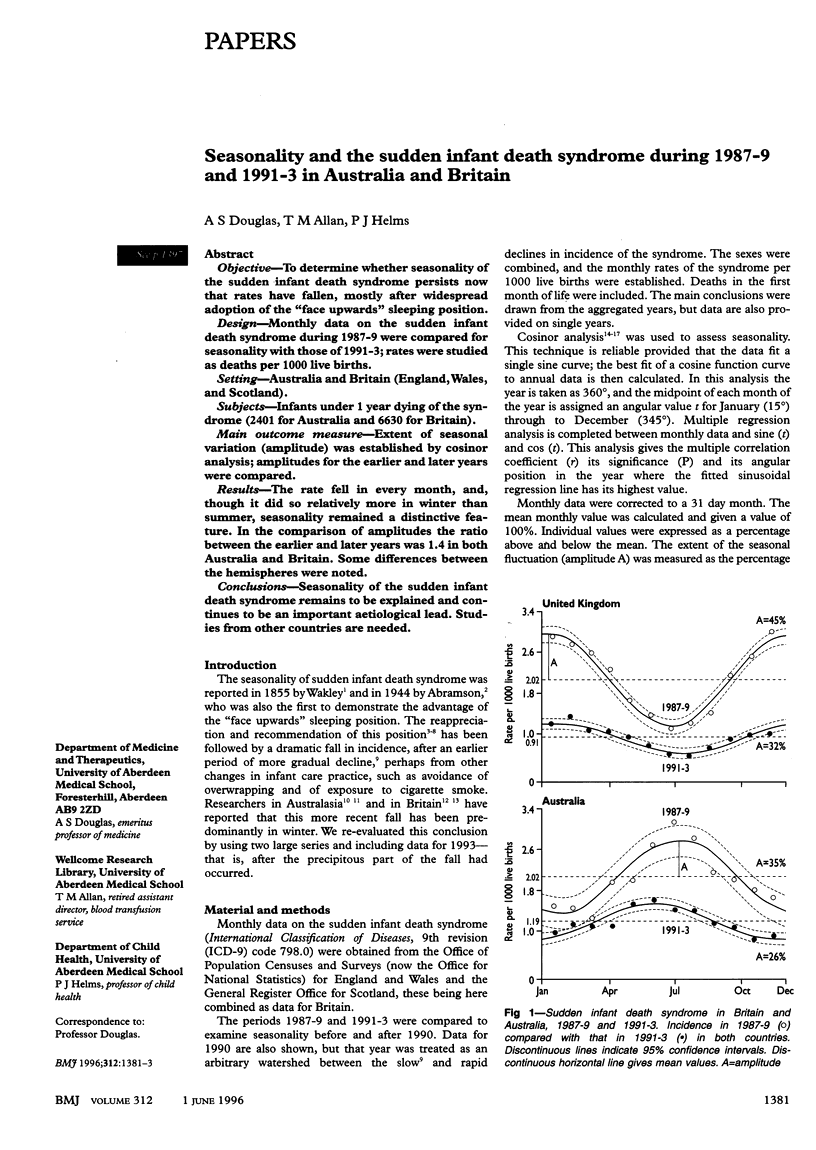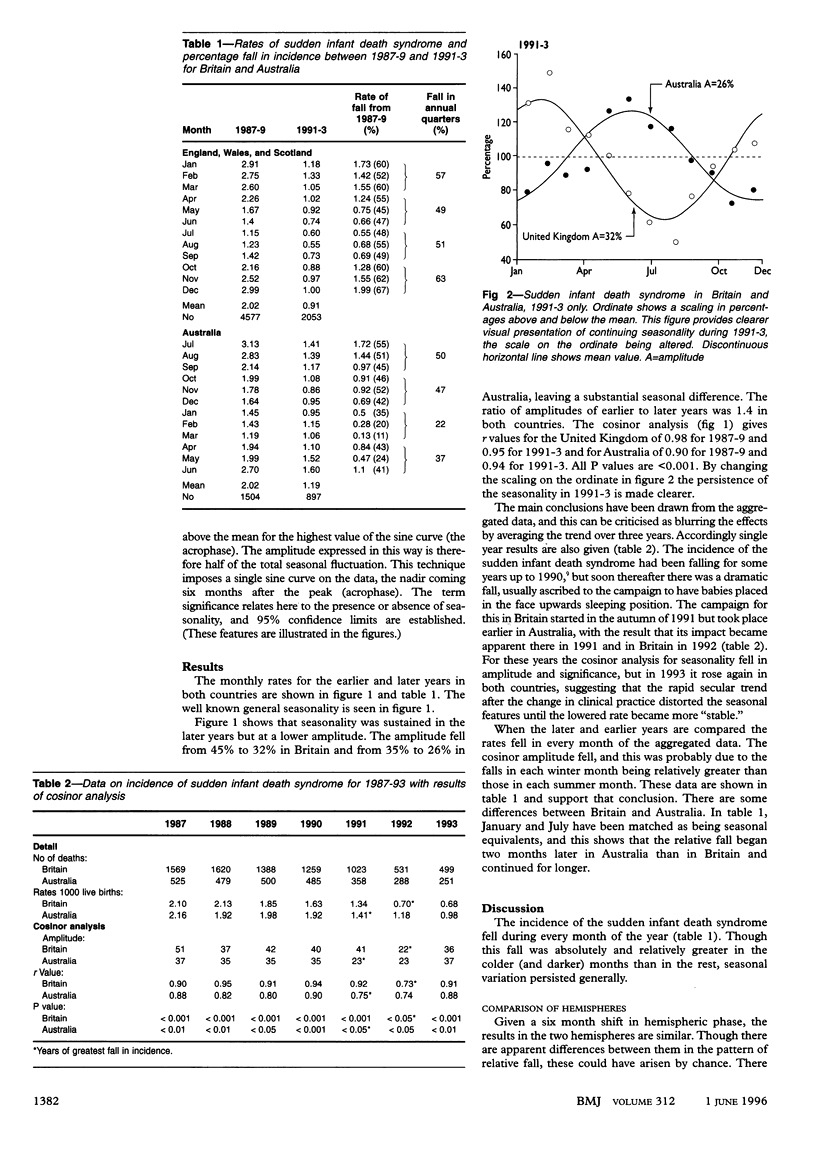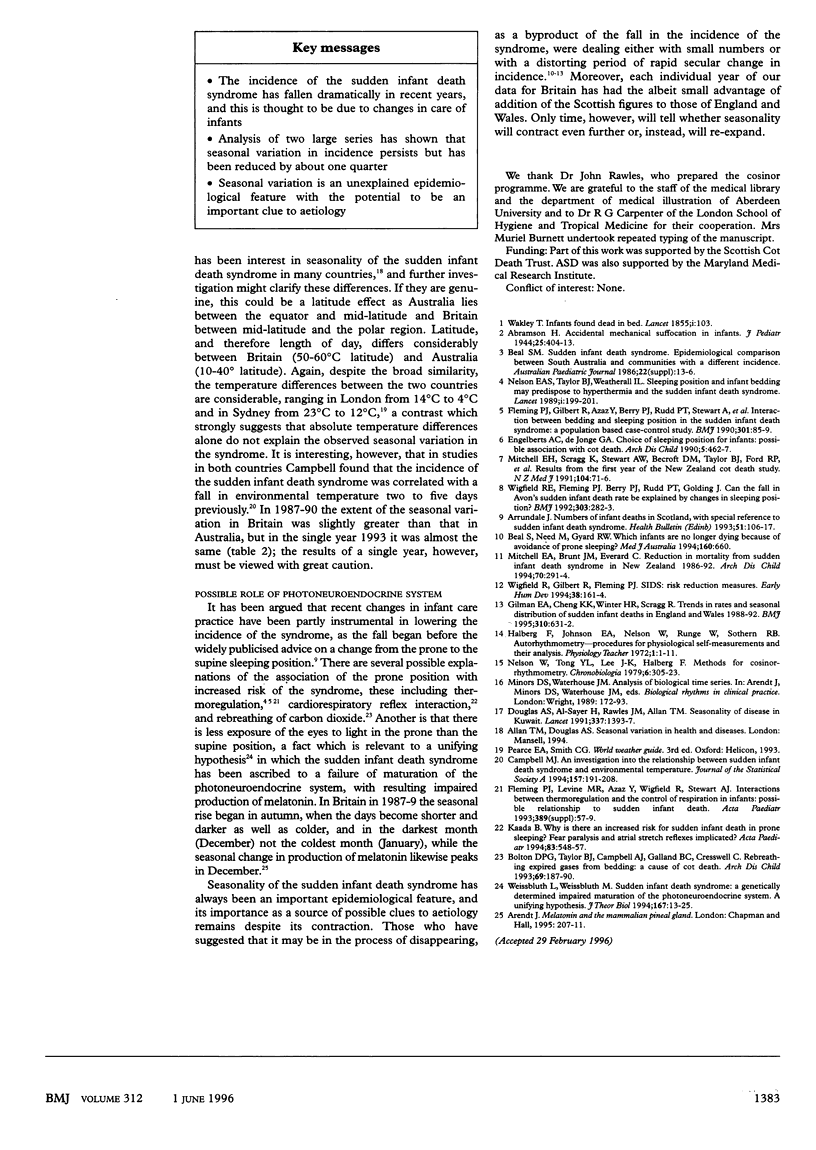Abstract
OBJECTIVE--To determine whether seasonality of the sudden infant death syndrome persists now that rates have fallen, mostly after widespread adoption of the "face upwards" sleeping position. DESIGN--Monthly data on the sudden infant death syndrome during 1987-9 were compared for seasonality with those of 1991-3; rates were studied as deaths per 1000 live births. SETTING--Australia and Britain (England, Wales, and Scotland). SUBJECTS--Infants under 1 year dying of the syndrome (2401 for Australia and 6630 for Britain). MAIN OUTCOME MEASURE--Extent of seasonal variation (amplitude) was established by cosinor analysis; amplitudes for the earlier and later years were compared. RESULTS--The rate fell in every month, and, though it did so relatively more in winter than summer, seasonality remained a distinctive feature. In the comparison of amplitudes the ratio between the earlier and later years was 1.4 in both Australia and Britain. Some differences between the hemispheres were noted. CONCLUSIONS--Seasonality of the sudden infant death syndrome remains to be explained and continues to be an important aetiological lead. Studies from other countries are needed.
Full text
PDF


Selected References
These references are in PubMed. This may not be the complete list of references from this article.
- Arrundale J. Numbers of infant deaths in Scotland, with special reference to sudden infant death syndrome. Health Bull (Edinb) 1993 Mar;51(2):106–117. [PubMed] [Google Scholar]
- Beal S., Need M., Byard R. W. Which infants are no longer dying because of avoidance of prone sleeping? Med J Aust. 1994 May 16;160(10):660–660. [PubMed] [Google Scholar]
- Bolton D. P., Taylor B. J., Campbell A. J., Galland B. C., Cresswell C. Rebreathing expired gases from bedding: a cause of cot death? Arch Dis Child. 1993 Aug;69(2):187–190. doi: 10.1136/adc.69.2.187. [DOI] [PMC free article] [PubMed] [Google Scholar]
- Douglas A. S., al-Sayer H., Rawles J. M., Allan T. M. Seasonality of disease in Kuwait. Lancet. 1991 Jun 8;337(8754):1393–1397. doi: 10.1016/0140-6736(91)93069-l. [DOI] [PubMed] [Google Scholar]
- Engelberts A. C., de Jonge G. A. Choice of sleeping position for infants: possible association with cot death. Arch Dis Child. 1990 Apr;65(4):462–467. doi: 10.1136/adc.65.4.462. [DOI] [PMC free article] [PubMed] [Google Scholar]
- Fleming P. J., Gilbert R., Azaz Y., Berry P. J., Rudd P. T., Stewart A., Hall E. Interaction between bedding and sleeping position in the sudden infant death syndrome: a population based case-control study. BMJ. 1990 Jul 14;301(6743):85–89. doi: 10.1136/bmj.301.6743.85. [DOI] [PMC free article] [PubMed] [Google Scholar]
- Fleming P. J., Levine M. R., Azaz Y., Wigfield R., Stewart A. J. Interactions between thermoregulation and the control of respiration in infants: possible relationship to sudden infant death. Acta Paediatr Suppl. 1993 Jun;82 (Suppl 389):57–59. doi: 10.1111/j.1651-2227.1993.tb12878.x. [DOI] [PubMed] [Google Scholar]
- Gilman E. A., Cheng K. K., Winter H. R., Scragg R. Trends in rates and seasonal distribution of sudden infant deaths in England and Wales, 1988-92. BMJ. 1995 Mar 11;310(6980):631–632. doi: 10.1136/bmj.310.6980.631. [DOI] [PMC free article] [PubMed] [Google Scholar]
- Kaada B. Why is there an increased risk for sudden infant death in prone sleeping? Fear paralysis and atrial stretch reflexes implicated? Acta Paediatr. 1994 May;83(5):548–557. doi: 10.1111/j.1651-2227.1994.tb13079.x. [DOI] [PubMed] [Google Scholar]
- Mitchell E. A., Brunt J. M., Everard C. Reduction in mortality from sudden infant death syndrome in New Zealand: 1986-92. Arch Dis Child. 1994 Apr;70(4):291–294. doi: 10.1136/adc.70.4.291. [DOI] [PMC free article] [PubMed] [Google Scholar]
- Mitchell E. A., Scragg R., Stewart A. W., Becroft D. M., Taylor B. J., Ford R. P., Hassall I. B., Barry D. M., Allen E. M., Roberts A. P. Results from the first year of the New Zealand cot death study. N Z Med J. 1991 Feb 27;104(906):71–76. [PubMed] [Google Scholar]
- Nelson E. A., Taylor B. J., Weatherall I. L. Sleeping position and infant bedding may predispose to hyperthermia and the sudden infant death syndrome. Lancet. 1989 Jan 28;1(8631):199–201. doi: 10.1016/s0140-6736(89)91211-7. [DOI] [PubMed] [Google Scholar]
- Nelson W., Tong Y. L., Lee J. K., Halberg F. Methods for cosinor-rhythmometry. Chronobiologia. 1979 Oct-Dec;6(4):305–323. [PubMed] [Google Scholar]
- Weissbluth L., Weissbluth M. Sudden infant death syndrome: a genetically determined impaired maturation of the photoneuroendocrine system. A unifying hypothesis. J Theor Biol. 1994 Mar 7;167(1):13–25. doi: 10.1006/jtbi.1994.1046. [DOI] [PubMed] [Google Scholar]
- Wigfield R. E., Fleming P. J., Berry P. J., Rudd P. T., Golding J. Can the fall in Avon's sudden infant death rate be explained by changes in sleeping position? BMJ. 1992 Feb 1;304(6822):282–283. doi: 10.1136/bmj.304.6822.282. [DOI] [PMC free article] [PubMed] [Google Scholar]
- Wigfield R., Gilbert R., Fleming P. J. SIDS: risk reduction measures. Early Hum Dev. 1994 Sep 15;38(3):161–164. doi: 10.1016/0378-3782(94)90208-9. [DOI] [PubMed] [Google Scholar]


